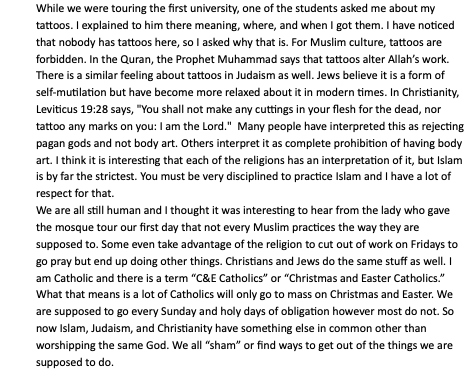Blogger 2: Religion and Personal Beliefs
Moroccan religious or celebratory music revolves around either the cleansing of the spirit, the celebration of a union, or for purely enjoyment purposes (Schuyler, 1981). One genre is called Gnawa and is known for being a traditional form of Islamic religious songs and rhythms founded in Morocco and West Africa. Unlike many of the songs heard in more tradition Catholic or conservative churches in the Western culture, the music is made to invoke rhythmic movements from the listener (Schuyler, 1981). Dancing is a major part of the culture surrounding Gnawa and other religious/celebratory music and the game of Txabia (a musical game of hide-and-seek) is an excellent example of how that music is used (Schuyler, 1981). After proper ceremonies, Txabia is used as a part of the ritual devoted to enjoyment after more serious moments where dancers are entranced (Schuyler, 1981). The musical ceremony we saw yesterday also encouraged free dancing and movement that was intertwined with both religious songs and modern dance music. Watching the members of the house dance, I noticed that their movements were no more or less restrictive during prayer songs, the songs/dance were just supposed to be about cleansing, defined in one’s own terms (Schuyler, 1981).
As Hamid was describing his relationship with these music ceremonies, I asked him if he had ever traveled to Morocco specifically to participate in one of these events. He said that he does so two or three times a year and asks friends to host a ceremony for him if he is feeling unwell or imbalanced. Hamid said that music and dance are spiritually, mentally, and physically healing and that not many people are aware of its power to transform the spirit. I particularly loved how he kept reiterating that you are allowed to do whatever you want during this time. The cleanse is however you interpret it to be and there is no “correct” way to conduct yourself. In reading about Moroccan music, Hamid’s remarks were confirmed with a quote saying, “As one woman explained: “When I hear the Gnawa, my skin feels as though it were touching a thorn branch; there is a feeling I cannot explain running through my bones. Sometimes I dance. That’s just when I hear them on the radio”” (Schuyler, 1981). Before Hamid got up from the table, he closed the conversation by saying with a smile, “the minute I hear the beat, I have to get up and dance.”
The way Hamid feels about Moroccan music is the same way that I that I feel when listening to bluegrass music. When I hear the music start, I cannot help myself to do anything but free myself to the beat. Around my friends I call it “cheerleading music” because of how drastically the music changes based upon the energy of the crowd and the effect it has upon each individual musician. Bluegrass music always reminds me of the saying “even the cheerleader needs a cheerleader.” When, for example, the fiddle player begins to feel the energy of the crowd and hears the shouts of encouragement, he begins to give himself to the instrument and his surrounding players shift how they are playing to “cheer” him on. It is music that is played at its best without any sort of rehearsed or planned songs, and it represents a beautiful symbiotic relationship between both the listener and the performer. Bluegrass may be a spiritual music for the audience, given as a gift by the performers, but its healing only works if the audience reciprocates with energy of their own. I love it because it requires this “cheerleading” and it is so powerful to me because it necessitates giving in to the beat and dancing, as Hamid says, “to cleanse your soul.”


As I read your reflection, I remembered a song by Bob Marley and the Wailers called Trenchtown Rock. In it he sings “One good thing about music, when it hits you feel no pain” (Bob Marley & the Wailers, 2003). Then I found an article by Rahman et al., (2021) that explored and found evidence that music affects emotions through dilation of pupils, skin temperature, electrodermal activity, and blood volume pulse.
ReplyDeleteLike you and Hamid, I also turn to music for its spirituality. I have specific songs that are perfect for when I need to relax, if I need motivation, for when I am vexed or sad, or for when I am just in a good mood. There is a song for that.
Bob Marley. (2003). Trenchtown Rock [Song]. On Live at the Roxy [Album]. Tuff Gong.
Rahman, J. S., Gedeon, T., Caldwell, S., Jones, R., & Jin, Z. (2020). Towards effective music therapy for mental health care using machine learning tools: Human affective reasoning and music genres. Journal of Artificial Intelligence and Soft Computing Research, 11(1), 5-20.